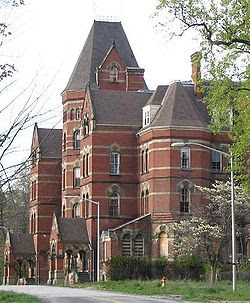In Walt Whitman's "Leaves of Grass" a collection of poems first published in 1855, the cultural status of the "lunatic asylum" peaked my interest. The following lines are two direct references to psychiatric hospitals or asylums:
"I saw the face of the most smeared and slobbering idiot they had at the asylum,"
I decided to look into the status of mental institutions in the 19th Century to see what kind of framework Whitman was working with. There were quite a few resources to choose from, though I chose to focus on Whitman's very own backyard of New York.
Kirkbride Buildings shot up all over the East Coast in the latter half of the 19th Century with generally the same floor plan for each building: "Once state-of-the-art mental healthcare facilities, Kirkbride buildings have long been relics of an obsolete therapeutic method known as Moral Treatment. In the latter half of the 19th century, these massive structures were conceived as ideal sanctuaries for the mentally ill and as an active participent in their recovery. Careful attention was given to every detail of their design to promote a healthy environment and convey a sense of respectable decorum. Placed in secluded areas within expansive grounds, many of these insane asylums seemed almost palace-like from the outside. But growing populations and insufficient funding led to unfortunate conditions, spoiling their idealistic promise."

Buffalo State Hospital: Buffalo, NY. Began in 1871 and finished in 1895.
Hudson River State Hospital for the Insane: Poughkeepsie, NY. Completed in 1871.

Utica State Hospital: Utica, NY. Yet, from its earliest days, Utica was overcrowded and underfunded. In 1843, the average daily population was 109 with a 49 percent recovery rate; by 1869 the population was 600, the recovery rate had dropped to 26 percent, and seven times as many insane persons were still in poorhouses. Although advocates of Brigham's "moral treatment" philosophy were hard pressed to admit that some cases were beyond their reach, a growing number of physicians and legislators began to see a separate category for the chronic insane; these patients were incurable, they argued, and they needed only custodial care.

Asylum on Blackwell's Island: New York City, NY. Established in 1839. "This asylum was part of a complex that included a penitentiary, an alms house, a smallpox hospital, and other institutions. At times, inmates from the penitentiary supervised the patients in the asylum."

New York City, NY. Established in 1808, location of former grounds: Columbia University, Morningside Heights. Isn't that insane??
All this to say, Walt Whitman was born on Long Island and grew up in and around New York. Lunatic Asylums appear in his writing because he was surrounded by them. This cultural context is very interesting and sheds light on a whole different aspect of "Song of Myself." These psychiatric hospitals sprang up throughout the 19th Century increasingly so in the latter half of the 1800's.


This is great...I'm so happy we both chose these loony bins. I mean there were so many asylums during this period, and I really do feel it had a direct impact on his writing, and his life. There are lots of little lines in the poem that hint to this, and at least speak to the general knowledge and acceptance of insane asylums.
ReplyDelete